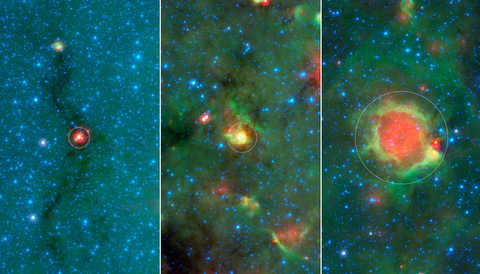Thanks to the help of the general public, astronomers have discovered a new signature marking a hidden phase of star formation.
A blue squiggle, green peas, and now yellowballs.

NASA / JPL-Caltech
Citizen scientists at Zooniverse take on the deceptively simple task of classifying objects in deep-space images. But they do far more than they’re asked, and they discover some curious things along the way.
Over the past few years, the general public has not only classified more than 900,000 galaxies by type and found more than 600,000 star-blown bubbles, they’ve also discovered objects like the famous Hanny’s Voorwerp and so-called green-pea galaxies. Now another oddball discovery is providing a new view of star formation.
Visitors to the Milky Way Project see a gallery of Spitzer Space Telescope infrared images of our galaxy. The stunning views are a nice perk to their job: finding bubbles in the Milky Way. New massive stars blow these giant bubbles, their stellar winds carving out hot cavities ringed by cooler organic molecules that glow green in the false-color images.
Before they emerge from their dusty cocoons, though, the not-yet-stars must grow from cool clumps of dense gas into ready-to-burn protostars, heating up their surroundings in the process. A citizen-science discovery has shown scientists a new way of seeing this hidden phase of star formation.
A citizen known by the username kirbyfood,was identifying bubbles in a Spitzer image when he came across a fuzzy yellow thing. Since he didn’t know how to classify it, he posted it in the Zooniverse forum.
A professional astronomer checking in on the forum tagged the object with the name #yellowball. Soon that identifier marked another 928 objects. Their yellow color comes from the combined glow of warm dust and organic molecules, whose emissions appear red and green, respectively, in the Spitzer images.
Researchers think the yellowballs mark the in-between phase that transitions cool clumps of gas and dust into newly formed stars.
Read about the discovery and study of yellowballs in NASA’s press release, Citizen Scientists Lead Astronomers to Mystery Objects in Space, and the full paper, “The Milky Way Project: What Are Yellowballs?”
 2
2
Comments
February 4, 2015 at 7:48 pm
Monica, awesome images! I just found an article about space visualization - http://intech.club/company/leapmotion/introducing-planetarium-the-design-and-science-behind-our-vr-widgets-showcase-087f1cc5
Do you plan to cover something like this on your site?
You must be logged in to post a comment.
February 7, 2015 at 9:54 am
A non-paywalled version of "The Milky Way Project: What are Yellowballs?" is available on arXiv: http://arxiv.org/abs/1502.01388
You must be logged in to post a comment.
You must be logged in to post a comment.